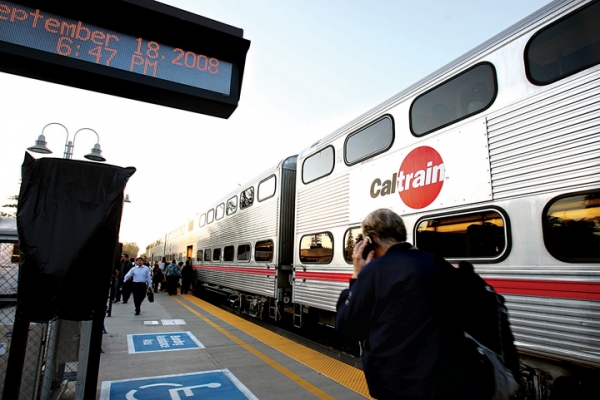A year after barely avoiding draconian service cuts, Caltrain officials have several reasons to feel optimistic even as they continue to scramble for new funding sources to keep the trains running.
The agency, which draws funding from transit districts in Santa Clara, San Mateo and San Francisco counties, withstood a financial crisis last year after the San Mateo County Transit District (Samtrans) drastically cut back its contributions, prompting other agencies to follow suit. The result was a $30 million deficit on a budget of roughly $100 million.
Related story: End of the line for Caltrain? (Feb. 11, 2011)
The good news for the cash-strapped agency is that its popularity continues to soar, thanks in large part to contributions from major employers such as the Stanford University Medical Center and Facebook, according to Yoriko Kishimoto, a former Palo Alto mayor who currently leads the group "Friends of Caltrain." Kishimoto, who updated the City Council Rail Committee on Caltrain's latest efforts Thursday morning, said that increased ridership has created a 25 percent revenue increase for Caltrain over last year, putting a dent into its operating deficit.
Stanford University Medical Center, for example, announced last month that it has already offered Caltrain Go Passes to all of its employees. As of mid-December, about 2,000 employees had signed on for the monthly passes. Kishimoto estimated that the hospitals' contribution brings Caltrain $1.4 million in annual revenues. Facebook, she said, has shuttles operating for each train.
"The good thing, overall, is that every month since then (last year's financial crisis), Caltrain ridership has been going up and revenues are going up," Kishimoto said.
But the recent uptick in revenue doesn't erase the need for a dedicated funding source, which Caltrain still lacks. One idea on the table for addressing the agency's long-term needs is a sales-tax increase for San Mateo County. Kishimoto said Caltrain will be conducting polls and surveys in the coming months to gauge the likelihood of such a measure passing. Another proposal, from state Assemblyman Jerry Hill, D-San Mateo, would raise the sales tax in all three counties to support Caltrain.
Kishimoto said Hill will detail his proposal at the Feb. 2 meeting of Friends of Caltrain.
Either tax proposal would have to be approved by voters before it's enacted.
Though her group hasn't taken a firm position on a particular funding measure, Kishimoto said a sales tax increase and Hill's three-county proposal so far seem to be the most promising solutions currently on the horizon.
Councilman Pat Burt, who represents Palo Alto on the Peninsula Cities Consortium, a coalition that meets regularly to discuss rail-related issues, said it's too early to decide which solution to support, given that the polling hasn't been conducted yet. Burt said the measure that currently looks "most promising" would likely be a sales-tax measure.
Kishimoto said Caltrain, as a regional service, is at a major disadvantage when it comes to competing for federal funds, which she said tend to go to urban projects such as subways or intercity services. While Caltrain stretches from San Francisco to San Jose, much of its ridership comes from the Peninsula. Palo Alto's downtown station is Caltrain's second busiest station after San Francisco.
"We're kind of in nowhere land," Kishimoto said. "Maybe Palo Alto can help be an advocate in saying that we're falling between the cracks -- that there's a new model for the United States, that we're a metropolitan area and we need funding for regional rail."



Comments